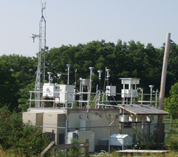Station Links
- Coming soon!
|
 |
||||||||||
|
The Addison site is located in southwest New York State within the boundaries of Pinnacle State Park at an elevation of approximately 504 m above sea level. It is located on the eastern slope of Orr Hill, part of the Allegheny Plateau of southern New York State and northern Pennsylvania. Orr Hill rises steeply from the Canisteo River Valley and the village of Addison. Immediately adjacent to the measurement site to the north and west is a nine-hole golf course operated as part of the State Park. Adjacent to the park on the east and north are undeveloped State Forest lands. The terrain is typical of the New York/Pennsylvania Twin Tiers region. The site is about 100 m east and about 10-15 m below the crest of the second highest hill in the park. It is located on a shale shelf, with the nearest trees about 50 m to the west and south. The surrounding area is a patchwork of vegetation types, including a nine hole golf course to the northwest (part of the park), mixed deciduous and coniferous forests, some former pastures and fields, and an approximately 50 acre pond to the south and below the site. The village of Addison (pop. ~1800) is about 4 km to the northwest and the town of Corning (pop. ~12,000) is 15 km to the northeast. The average annual temperature at this site is 7.8°C; and the average temperature range is from -18 to 31°C. From the establishment of the site in 1995 until June of 1999, the equipment was housed in a 2.5 m by 10 m by 2.2 m RV owned by the New York State Department of Environmental Conservation and operated by ASRC under memorandum of understanding. The vehicle was climate controlled to provide a stable operating temperature. The top of the vehicle was ringed with a grated aluminum deck. A folding meteorological tower reached a height of 10 m above the ground when fully raised. This folding tower was blown down in gust of wind in March of 1998 and replaced with the freestanding 10 m tower. Trace gas sample inlets and radiation measurement instruments were mounted about 2 m off the aluminum deck, or about 5 m above the ground. Barometric pressure was measured inside the vehicle. In 1999 the RV was replaced by a 2.4m by 7.3m Ekto air monitoring shelter. The shelter is climate controlled and adjacent to a folding 10 m meteorological tower. The roof of the shelter is surrounded by a railing, and the trace gas inlets are mounted to or braced against these rails. Instruments and samplers for the measurement of particulate matter (primarily PM2.5) began to be deployed at the site in the late summer of 1999. Inlets for all PM instruments are at the same height, 5 meters above ground level, and 2 meters above the shelter roof. The samplers collecting integrated filter samples are all located outside, either attached to the roof deck, or mounted on a nearby platform. The continuous and semi-continuous PM instruments, with one exception, are installed inside the shelter and have straight metal inlet tubes which penetrate the shelter roof. The inlet for O3, CO, NO/NO2, SO2, and the Auto GC is at a height of 5 m and consists of a 1" glass tube capped by a PFA screen with 1 mm openings. The original installation consisted of a 1" FEP Teflon inlet tube, but this was replaced by glass in 1997. The glass inlet tube leads to a heated ACE glass manifold, from which the analyzers draw samples. A blower capable of 60 CFM in free air is installed at the downstream end of the sample manifold, where the excess sample air is exhausted back to the atmosphere. The NOY/HNO3 (formerly NO/NOY) sample inlets protrude from a SS NEMA 4 enclosure which is mounted directly adjacent to the common 1" glass inlet and consists of a 0.5" PFA and glass tubes leading directly to two heated molybdenum converters, from which 0.25" PFA tubes bring separate NOY and (NOY-HNO3) samples down to the analyzer. The inlet line for the whole air hydrocarbon canister samples collected from 1995-1998 the inlet line was a 304 stainless steel 0.25" tube fastened to the meteorological tower at a height of roughly 8 m above ground level. The radiation sensors for UV and total solar radiation are also mounted about 2 m above the roof level (or 5 m above the ground), at the southernmost corner of the roof. |
|||||||||||



